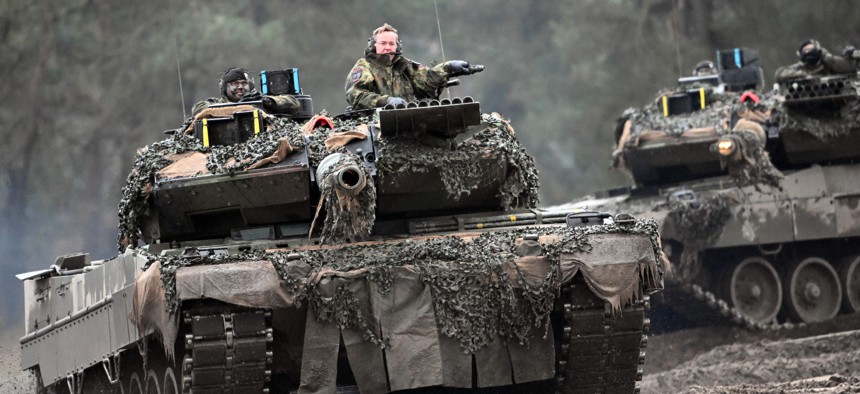JOHN R. DENI

Germany’s insistence that the United States move first in the decision to send tanks to Ukraine tells us much about security dynamics in Europe, but it also has implications for America’s strategy in the Indo-Pacific: it reveals the futility of hoping that Europe might soon stand on its own so that Washington can focus more on the Pacific theater.
Deliberations over whether to send tanks to Ukraine took longer than many hoped, but the end result should nonetheless help increase the odds of a Ukrainian victory. The deal was clinched by U.S. willingness to take the lead, announcing it would supply Ukraine with American-made M1A2 Abrams tanks, even though these tanks require a more robust maintenance and logistical support capability. Moreover, Washington will only provide 31 Abrams tanks—just 10 percent of what Ukraine has apparently indicated it needs—and they won’t arrive in any case for several months, meaning they probably won’t play any role in an expected Ukrainian counteroffensive this spring.
The fact that Germany in particular refused to provide tanks without America doing so first is frustrating to Washington. Berlin alone has the economic, technological, and political heft to lead Europe; other candidates all fall short for various reasons. Great Britain is looking increasingly less “great,” thanks in large part to Brexit, which is forcing its military to shrink. France has the will to lead but lacks the economic and military strength; Macron’s commitment to expand military spending from 2024-30 will take years to yield results. Paris also lacks the respect of Eastern Europeans, who perceive it as too willing to negotiate with Moscow over the heads of Warsaw, Prague, Vilnius, and so forth. Farther afield, Italy and Spain appear largely uninterested in a broader leadership role in Europe – perhaps more importantly, they both have their eyes trained on instability to the south and the waves of migrants it generates.
Germany’s singular heft notwithstanding, it currently lacks the will to lead. Berlin steadfastly avoids getting ahead of either international or domestic opinion. Internationally, Berlin is unwilling to act without consensus among allies, otherwise known as “leading from the middle.” Domestically, German leaders reflected the reluctant but slowly shifting sentiment among the German electorate.
Moreover, Berlin still wants the United States in the pole position when it comes to security matters in Europe. After all, Germany lacks a nuclear deterrent of its own, remaining reliant on America’s umbrella. And the albatross of historical guilt remains around Berlin’s neck when it comes to sending military forces or even military equipment anywhere but especially in Eastern Europe.
All of this has implications for the United States, certainly in Europe but also well beyond. First, it’s clear that for the foreseeable future, Washington will need to lead actively in Europe. Even if war in Ukraine ended tomorrow with a victory for Kyiv, however that’s defined, any subsequent attempt by Washington to pull up stakes in Europe or ‘lead from behind’ is likely to backfire. Prematurely backing away from Europe would endanger enduring vital American interests there.
More consequentially, in the event of a crisis in the Indo-Pacific, Washington can’t rely on Europeans to completely ‘backfill’ the United States in Europe. Aside from the lack of will in Germany – the only major European ally with the wherewithal to lead – most major U.S. allies in Europe are either limiting or reducing their military capacity while they focus on building capabilities over this decade.
As it has for several generations—and because it has vital interests across two oceans—America will probably need to maintain its leading security role in East Asia and Europe. In Europe, the character of that role may change somewhat. For instance, it may mean a different configuration of U.S. forces based in Europe following a Ukrainian victory. But the United States will still need to sit at the head of the table, leading from the front.
In the Indo-Pacific, the United States will need to maintain and strengthen its ability to project military force and political influence across the Pacific’s vast distances and over time. However, and to the extent possible, Washington should continue to prioritize keeping strategic competition with China within the realms of economics, trade, governance, diplomacy, development, and information. Relying too strongly on a military framing for competition with China risks becoming a self-fulfilling prophecy and could result in overextension or worse.
Although China remains the primary long-term challenge to American interests and security, it’s equally clear Russia will remain a spoiler in Europe at least through the end of this decade and possibly longer. Moscow’s conflation of security and subservient buffer states is likely to continue running headlong into the West’s vital interest in sovereignty and self-determination. The deal to send tanks to Ukraine should remind Washington that it must continue to exercise leadership in both theaters vital to the American way of life, carefully balancing the resources necessary to do so in each.
No comments:
Post a Comment